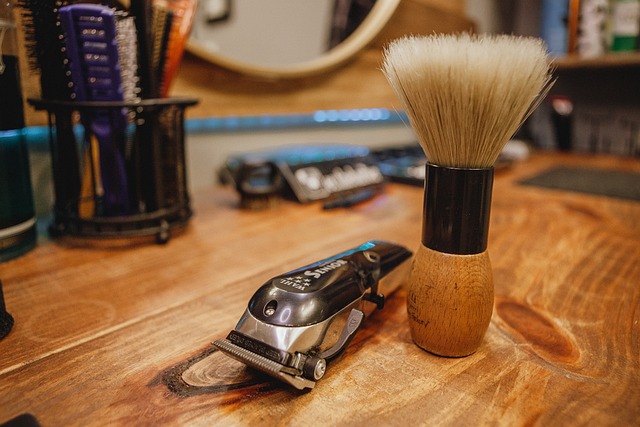TRIM & SHAPE
Maintaining well-groomed facial hair goes beyond simply growing it out; it entails regular trimming and shaping to achieve a polished and intentional look. The importance of trim and shaping cannot be overstated, as it helps enhance facial features, create symmetry, and project a well-maintained appearance. By taking the time to trim and shape facial hair, individuals can define their jawline, highlight their cheekbones, and even create the illusion of a more structured face. Additionally, proper grooming can help prevent unruly or stray hairs, promoting a neat and tidy overall aesthetic. Whether it’s a full beard, moustache, or stubble, giving attention to trim and shape allows for more control and customization, ensuring that facial hair remains a complementing feature rather than a distraction.

Trim and shape tools
When it comes to trimming and shaping your beard or moustache, several tools can help you achieve a well-groomed look. Here are some commonly used tools:
-
Beard Trimmer: A beard trimmer is a versatile tool specifically designed for maintaining facial hair. It usually comes with adjustable length settings and different attachments to trim hair to a desired length. Beard trimmers are available in both corded and cordless options.
-
Scissors: Sharp, straight-edge scissors are essential for precise trimming. They are particularly useful for trimming stray or longer hairs that may need extra attention. Scissors with rounded tips are recommended to minimize the risk of accidentally nicking the skin.
-
Comb: A beard comb or mustache comb helps in untangling and straightening the hair, making it easier to trim and shape. It also allows for more precise control during the trimming process.
-
Precision Trimmer: Some electric trimmers or grooming kits come with a smaller precision trimmer attachment specifically designed for detailing and shaping. This attachment is handy for creating sharp lines, defining edges, and tidying up hard-to-reach areas like the upper lip or cheek lines.
-
Beard Shaping Tool: A beard shaping tool is a template or guide that helps maintain symmetry and define the shape of the beard or moustache. These tools often have different curves, angles, and lines that can be placed against the face to serve as a guide for trimming and shaping.
-
Electric Shaver: An electric shaver with a foil or rotary head can be useful for achieving a smooth, clean shave around the edges or for maintaining a clean-shaven neck area if desired.
Remember, it’s important to use these tools with care and practice patience when trimming and shaping your facial hair. Start with longer settings or lengths and gradually trim to your desired style, checking the symmetry and balance as you go along.

Trim and shape your beard to fit your face type
Finding the most suitable beard shape based on your face involves considering your face shape and working to complement its natural contours. Here’s a step-by-step guide to help you determine your beard shape:
-
Determine Your Face Shape: Identify your face shape by examining the proportions of your forehead, cheekbones, jawline, and chin. The common face shapes include round, square, oval, rectangular, diamond, and heart-shaped.
-
Research Beard Styles for Your Face Shape: Once you know your face shape, research beard styles that tend to complement it well. For example:
- Round face: A beard with more length on the chin and shorter sides can help add length and create a more angular appearance.
- Square face: A short, well-trimmed beard that maintains the natural angles of the face can accentuate the square jawline.
- Oval face: An oval face shape is versatile and can accommodate various beard styles, including full beards, short beards, or even clean-shaven looks.
- Rectangular face: A shorter beard or a well-trimmed beard with fuller sides can help balance the length of the face.
- Diamond face: A beard that adds width to the chin while keeping the sides shorter can help soften the angles of a diamond-shaped face.
- Heart-shaped face: A beard with more volume on the chin and a narrower shape towards the cheeks can help balance the wider forehead.
-
Consider Facial Hair Growth Patterns: Take note of your natural beard growth patterns. Some individuals may have areas with patchy or thin hair growth, while others may have denser growth in specific regions. Understanding your growth patterns can influence the beard style you choose and how you shape it.
-
Experiment and Seek Professional Advice: Start with a shorter beard length and gradually grow it out to experiment with different styles. You can also consult with a professional barber or stylist experienced in beard grooming. They can provide personalized recommendations based on your face shape, hair growth patterns, and desired style.
-
Maintain Regular Trims and Grooming: Once you’ve determined your ideal beard shape, maintain regular trims and grooming to keep it well-maintained. Use the appropriate tools, such as beard trimmers, scissors, and combs, to shape and neaten your beard as needed.
Remember that everyone’s face is unique, and personal preferences play a role in choosing a beard shape. It’s important to find a style that makes you feel confident and comfortable.
Trim and shape aftercare
After shaping and trimming your beard, it’s essential to follow a proper aftercare routine to maintain its appearance and health. Here are some tips for beard aftercare:
-
Cleanse and Moisturize: Wash your beard regularly with a mild beard shampoo or cleanser to keep it clean and free from dirt, debris, and excess oils. After washing, apply a beard conditioner or beard oil to moisturize the hair and skin beneath, promoting softness and preventing dryness.
-
Brush and Comb: Use a beard brush or comb to keep your beard neat and detangled. Brushing or combing helps distribute natural oils and stimulates the hair follicles. It can also train the beard to grow in the desired direction, enhancing the shape and style.
-
Trim Regularly: Even after shaping your beard, it’s important to maintain regular trims to control the length and shape. Trim any stray or split ends to prevent them from affecting the overall appearance. Invest in a quality beard trimmer or visit a professional barber for consistent maintenance.
-
Shape with Precision: Use a precision trimmer or razor to refine the edges and boundaries of your beard. Define your cheek lines, neckline, and mustache edges for a well-groomed look. Take your time and pay attention to detail to achieve a clean and polished appearance.
-
Practice Patience: Growing and maintaining a great-looking beard takes time and patience. Avoid the temptation to trim too much or make drastic changes too frequently. Allow your beard to grow and settle into its shape, making minor adjustments along the way to achieve your desired look.
-
Hydrate and Nourish: Keep your beard and the underlying skin hydrated by drinking plenty of water and maintaining a healthy diet. Moisturize the skin with a beard oil or balm to prevent itchiness, dryness, and flakiness.
-
Protect from Elements: Shield your beard from harsh weather conditions, such as extreme cold or excessive sun exposure. Consider using a beard balm or wax to provide a protective barrier against environmental factors.
Remember, each beard is unique, and your aftercare routine may need some customization based on your beard type and personal preferences. Regular care and attention will help keep your beard looking its best and ensure a healthy, well-maintained facial hair appearance.
